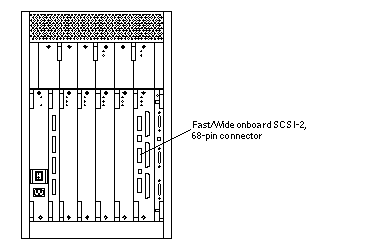Connecting External SCSI Devices
External SCSI-2 devices connect to your system through the built-in single-ended Fast/Wide SCSI-2 port on I/O+ boards (except for the board in slot 1), or through FSBE/S, DSBE/S, SWIS/S, or DWIS/S SBus cards installed on I/O+ boards.
Note -
The onboard SCSI-2 bus on the I/O+ board in slot 1 controls internal media tray devices. Therefore, the external SCSI connector on the I/O+ board in slot 1 must always have a terminator installed.
Note -
The maximum combined length for a string of SCSI cables is 6 meters for non-differential cables. For differential SCSI cables, the maximum is 25 meters. When calculating the total length of a SCSI string, include external cables, internal cables, and printed traces. Table 2-3 lists internal measurements for the Enterprise servers.
Table 2-3 Internal SCSI Lengths (Approximate)
|
Location |
Internal Length |
|---|---|
|
SBus+ I/O board |
0.43 meter |
|
Graphics+ I/O board |
0.43 meter |
For information on device addressing, priorities, and slot assignments, refer to "Rules for System Configuration" in the Sun Enterprise 3500 System Reference Manual, part number 805-2630.
Risk of equipment damage. Do not assign the same SCSI address to two devices sharing the same SCSI bus or SBus card.
To connect an external SCSI device to your system:
-
Connect a SCSI cable to the appropriate SCSI-2 host on the I/O+ board.
-
For the I/O+ board in slot 1, this is an SBus card installed in an appropriate SBus slot.
-
For I/O+ boards in slots 2 through 5, use the onboard SCSI-2 port or an SBus card installed in an appropriate SBus slot. Figure 2-13 shows the location of the onboard single-ended SCSI connector on the I/O+ board.
Figure 2-13 Onboard Single-ended SCSI Connector on the I/O+ Board

-
-
Connect the other end of the SCSI cable to the external SCSI-2 device.
-
Power on the system and test the server.
- © 2010, Oracle Corporation and/or its affiliates
